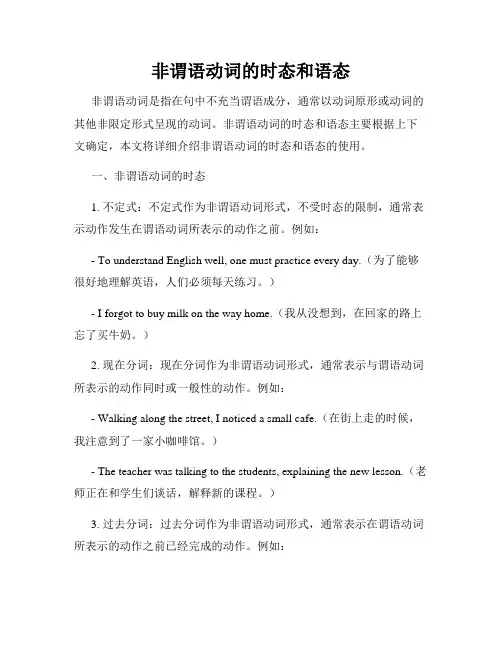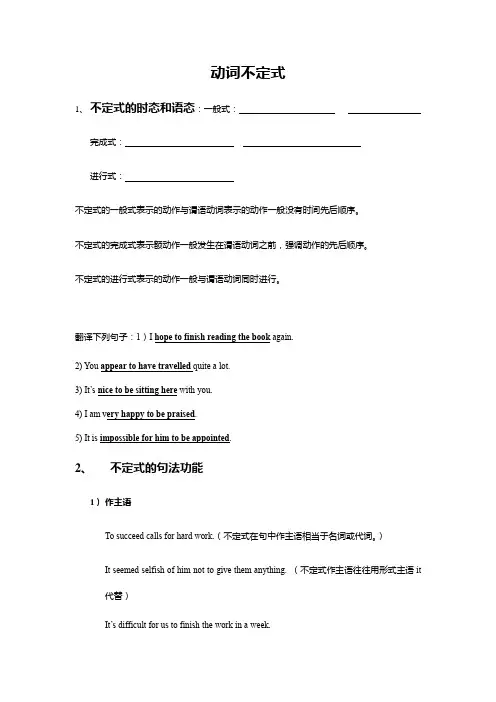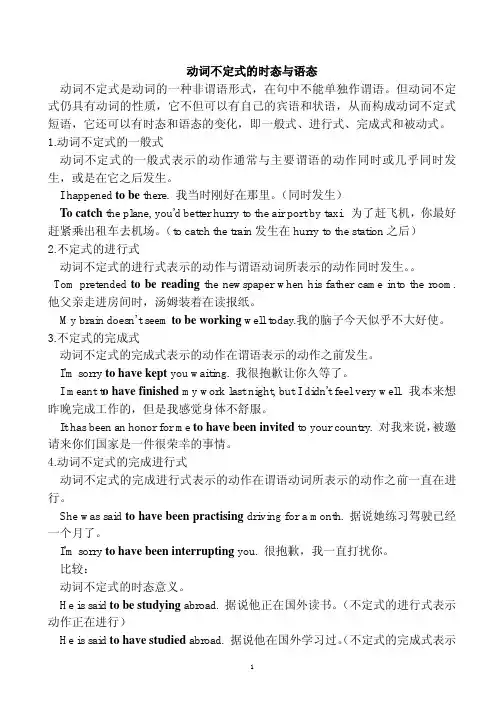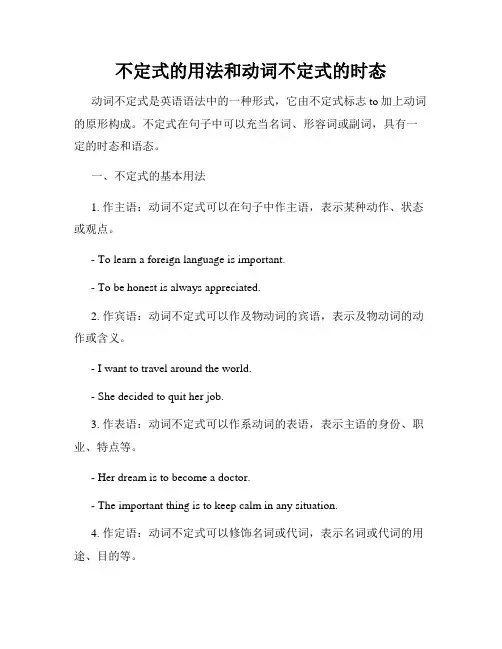不定式时态和语态
- 格式:docx
- 大小:58.56 KB
- 文档页数:9


非谓语动词的时态和语态非谓语动词是指在句中不充当谓语成分,通常以动词原形或动词的其他非限定形式呈现的动词。
非谓语动词的时态和语态主要根据上下文确定,本文将详细介绍非谓语动词的时态和语态的使用。
一、非谓语动词的时态1. 不定式:不定式作为非谓语动词形式,不受时态的限制,通常表示动作发生在谓语动词所表示的动作之前。
例如:- To understand English well, one must practice every day.(为了能够很好地理解英语,人们必须每天练习。
)- I forgot to buy milk on the way home.(我从没想到,在回家的路上忘了买牛奶。
)2. 现在分词:现在分词作为非谓语动词形式,通常表示与谓语动词所表示的动作同时或一般性的动作。
例如:- Walking along the street, I noticed a small cafe.(在街上走的时候,我注意到了一家小咖啡馆。
)- The teacher was talking to the students, explaining the new lesson.(老师正在和学生们谈话,解释新的课程。
)3. 过去分词:过去分词作为非谓语动词形式,通常表示在谓语动词所表示的动作之前已经完成的动作。
例如:- Having finished his homework, the boy went out to play.(孩子做完作业后,出去玩了。
)- The injured man was taken to the hospital, accompanied by his family.(受伤的人被他的家人陪同着送到了医院。
)二、非谓语动词的语态非谓语动词的语态主要包括主动语态和被动语态,具体如下:1. 不定式的语态:不定式的语态通常与主句的语态保持一致。
例如:- She wants to be promoted.(她想要升职。

不定式的时态+不定式的语态不定式的时态1. 一般时(to do);I begin to understand the truth.Would you like to come to my birthday party?Did you go to visit the Great Wall last year ?2. 现在时(to be doing);He seems to be following us.I happened to be standing next to him when he fell to the ground.The teacher happened to be correcting our papers when I came in.3. 完成时(to have done);He seems to have caught a cold.Im sorry to have given you so much trouble.I hope to have finished the work by now.4. 完成进行时(to have been doing);He seems to have been waiting a long time.He pretended to have been studying.He was said to have been teaching in high school for 2 years.不定式的被动语态1.不定式一般时的被动语态(to be done);Did it need to be done so soon?She cant bear to be laughed at.There was a lot of rubbish to be got rid of.2.不定式完成时的被动语态(to have been done);Im pleased to have been given this opportunity.The work seemed to have been finished before the deadline. Its said to have been built in the Ming dynasty.。

动词不定式1、不定式的时态和语态:一般式:完成式:进行式:不定式的一般式表示的动作与谓语动词表示的动作一般没有时间先后顺序。
不定式的完成式表示额动作一般发生在谓语动词之前,强调动作的先后顺序。
不定式的进行式表示的动作一般与谓语动词同时进行。
翻译下列句子:1)I hope to finish reading the book again.2) You appear to have travelled quite a lot.3) It’s nice to be sitting here with you.4) I am v ery happy to be praised.5) It is impossible for him to be appointed.2、不定式的句法功能1)作主语To succeed calls for hard work.(不定式在句中作主语相当于名词或代词。
)It seemed selfish of him not to give them anything. (不定式作主语往往用形式主语it 代替)It’s difficult for us to finish the work in a week.2)作宾语不定式一般作动词的宾语,不直接作介词的宾语,但“疑问词+不定式”结构可以作介词的宾语。
如:Y our father has at last decided to quit smoking.Talk with friends about where to shop.只接to do 作宾语的常见动词有:afford, agree, arrange, ask, care, choose, decide, demand, determine, expect, help, hope, plan, hesitate, long, manage, offer, prepare, refuse, pretend, promise, want, intend ,prefer3)作表语,可以表示主语的具体内容,目的。

动词不定式的时态与语态动词不定式是动词的一种非谓语形式,在句中不能单独作谓语。
但动词不定式仍具有动词的性质,它不但可以有自己的宾语和状语,从而构成动词不定式短语,它还可以有时态和语态的变化,即一般式、进行式、完成式和被动式。
1.动词不定式的一般式动词不定式的一般式表示的动作通常与主要谓语的动作同时或几乎同时发生,或是在它之后发生。
I happened to be there. 我当时刚好在那里。
(同时发生)To catch the plane, you'd better hurry to the air port by taxi. 为了赶飞机,你最好赶紧乘出租车去机场。
(to catch the train发生在hurry to the station之后)2.不定式的进行式动词不定式的进行式表示的动作与谓语动词所表示的动作同时发生。
Tom pretended to be reading the newspaper when his father came into the room. 他父亲走进房间时,汤姆装着在读报纸。
My brain doesn’t seem to be working well today.我的脑子今天似乎不大好使。
3.不定式的完成式动词不定式的完成式表示的动作在谓语表示的动作之前发生。
I'm sorry to have kept you waiting. 我很抱歉让你久等了。
I meant t o have finished my work last night, but I didn't feel very well. 我本来想昨晚完成工作的,但是我感觉身体不舒服。
It has been an honor for me to have been invited to your country. 对我来说,被邀请来你们国家是一件很荣幸的事情。
4.动词不定式的完成进行式动词不定式的完成进行式表示的动作在谓语动词所表示的动作之前一直在进行。




英语中不定式的时态、语态和用法讲解在谓语以外的句子成分中使用的动词一定要变词形(不能用动词原形),把动词原形变成不定式、-ing式或者过去分词,所以我们把这三种动词形式称为非谓语动词。
不定式的时态和语态:不定式共有4种时态形式(均是主动语态),另有2种被动语态形式:不定式的用法:不定式可以充当主语、表语、宾语、定语、状语。
1)作主语To work hard doesn’t necessarily mean getting high grades.下苦功不一定就能获得高分。
For one to do a good deed is very easy.一个人做一件好事很容易。
2)作表语My job is to take care of children.我的工作是照看小孩。
Her plan is to build a highway for the villagers.她的计划是为村民们建一条公路。
3)作宾语不定式作宾语的场合很多,以下是能够带不定式作宾语的动词:ask, want, agreeexpect, like, hatehope, wish, trystart, begin, offerprefer, continue, manageforget, promise, meanintend, attempt, decidedetermine, pretend, learndesire, choose, telladvise, show, discussI asked to be the first volunteer.我要求当第一名志愿者。
Do you want to leave here?你想要离开这里?We all agreed to do the spring cleaning.我们都同意过进行春季大扫除的。
He hopes to be chosen.他希望被选中。
有几十个动词后面不能接不定式作宾语,只能接-ing式,查阅公众号宾语部分。

动词不定式用法不定式是动词的一种非限定式,它是不受主语的单复数、人称、等的限定及影响的一种动词形式,但有时态和语态的变化。
一、动词不定式的基本结构动词不定式的基本形式为:to+动词原形,有时可不带to。
不定式的否定形式是:not to+动词原形。
在句中除不能作谓语外,其他成分都可作。
如:主语、表语、宾语、宾语补足语、定语和状语等。
注意:不定式之前的to(又称为小品词)与介词to的功能不同。
介词to之后要接名词或代词的宾格,或相当于名词的短语作它的宾语;而不定式符号to的后面需要跟动词原形。
speak to him (to 是介词) 对他讲话to speak English (to 是不定式的小品词) 讲英语二、动词不定式的用法不定式在句中有各种作用,一般可归类为三种基本用法:作名词,作形容词,作副词。
(一) 不定式作名词的用法不定式起名词作用,在句子中担当主语、表语、宾语和宾语补足语。
⒈作主语名词用法的不定式和名词一样,可担任句子的主语。
To grow more trees here is very important.(=It is very important to grow more trees here.) 在这里多种些树是非常重要的。
To hear your voice is so nice.(=It is so nice to hear your voice.) 听到你的声音真高兴。
To speak English well is not easy for me.(=It is not easy for me to speak English.) 把英语说好对我来说并不容易。
To walk to school takes me twenty minutes.(=It takes me twenty minutes to walk to school.) 步行到学校我要花20分钟。
注意:在It is… to…”的句型中,it是形式主语,真正的主语是不定式;使用这种结构,可以避免句子的头重脚轻。

不定式的用法和动词不定式的时态动词不定式是英语语法中的一种形式,它由不定式标志to加上动词的原形构成。
不定式在句子中可以充当名词、形容词或副词,具有一定的时态和语态。
一、不定式的基本用法1. 作主语:动词不定式可以在句子中作主语,表示某种动作、状态或观点。
- To learn a foreign language is important.- To be honest is always appreciated.2. 作宾语:动词不定式可以作及物动词的宾语,表示及物动词的动作或含义。
- I want to travel around the world.- She decided to quit her job.3. 作表语:动词不定式可以作系动词的表语,表示主语的身份、职业、特点等。
- Her dream is to become a doctor.- The important thing is to keep calm in any situation.4. 作定语:动词不定式可以修饰名词或代词,表示名词或代词的用途、目的等。
- I have a book to read.- We have a meeting to attend tomorrow.5. 作状语:动词不定式可以在句中作状语,表示目的、原因、结果、时间等。
- He exercises every day to stay healthy. (目的)- She cried so hard as to lose her voice. (结果)二、动词不定式的时态动词不定式有两种时态:一般时和完成时。
1. 一般时不定式:使用动词的原形表示不定式的一般时态。
- I hope to visit my grandparents next week.- She likes to read books in her free time.2. 完成时不定式:使用动词的完成时形式,由“to have + 动词的过去分词”构成。
一、非谓语动词的定义:非限定动词,在句中不能单独作谓语,因此也叫非谓语动词,包括动词不定式(the infinitive)、动名词(the gerund)、现在分词(the Present participle)、过去分词(the Past Participle)四种形式。
现把其用法辨析如下非谓语动词的句法作用(表一)二.非谓语动词的时态和语态:1.不定式的时态和语态(表二)(表三)(表四)通过上述几个表格的比较,我们可以知道四种非谓语动词的时态和语态形式,下面我们再总结一下:1.非谓语动词的否定式:一律直接在非谓语动词之前加not 即可。
例如:(1)The doctor advised me not to smoke.(2)I regret not having gone together with her.(3)Not having been there before, I don’t know the shortest way to the railway station.(4)Not educated well, he found it difficult to solve such a complicate problem.2.非谓语动词的完成式:不定式的否定式我们只要在原来不定式中的动词之前加have即可,然后把原来的动词变为它的过去分词即可,如to do→not have done. 而过去分词只有一种形式,即done.下面我们重点来看现在分词和动名词的完成形式。
现在分词和动名词完成形式是完全一样的,其变化规律是:一律在现在分词或动名词的一般式之前加having→having done,再把原来的现在分词或动名词变为它的过去分词。
如stud y →having studied3.非谓语动词的被动式:不定式的被动:看表二现在分词和过去分词的被动:看表三动名词的被动:看表四从第二点我们可以知道现在分词和过去分词都可以表被动,那么他们有什么区别?区别:现在分词的被动形式除了可以表示被动之外,还可以表示进行过去分词除了表示被动之外还可以表示完成例如:(1)The house being built now will be a hospital.(2) The house built last year is a hospital.下面我们重点讨论一下现在分词和过去分词在句子中的用法。
不定式的时态语态[不定式的时态和语态总结归纳] 小编给大家总结了不定式的时态和语态,希望对大家的英语学习有帮助。
不定式的时态和语态:时态\语态主动被动一般式to do to be done进行式to be doing完成式to have done to have been done完成进行式to have been doing不定式的用法:1) 现在时:一般现在时表示的动词,有时与谓语动词表示的动作同时发生,有时发生在谓语动词的动作之后。
He seems to know this.I hope to see you again. = I hope that I'll see you again.我希望再见到你。
2) 完成时:表示的动作发生在谓语动词表示的动作之前。
I'm sorry to have given you so much trouble.He seems to have caught a cold.3) 进行时:表示动作正在进行,与谓语动词表示的动作同时发生。
He seems to be eating something.4) 完成进行时:She is known to have been wreaking on the problem for many years.单项选择:( )1. The teacher told them ________ make so much noise.A. don’tB. notC. will notD. not to( )2. My mother often tells me _______so many mistakes.A. not to makeB. to not makeC. don’t makeD. not make( )3. Tell him _______ the window.A. to shut (关)notB. not to shutC. to not shutD. not shut( )4. The boy wanted to ride his bicycle in the street, but his mother told him ______. A. not to B. not to do C. not do it D. do not to( )5. Mrs Smith warned(警告) her daughter ________ after drinking.A. never to driveB. to never driveC. never drivingD. never drive( ) 6. The doctor asked the patient ____rich food after the operation(手术).A. to eat notB. eating notC. not to eatD. not eating( )7. The workers want us ________ together with them.A. workB. workingC. to workD. worked( )8. I saw him _______ out of the room.A. goB. wentC.is goingD. goes( )9. He often makes his little sister _____,A. cryB. cryingC. criedD. to cry( )10 There’re so many kinds of new bikes on sale that I can’t make up my mind _____ to buy.A. whatB. whichC. howD. where( )11. He can’t decide ______ to stay or not.A. whetherB. ifC. eitherD. if he will( )12. --- The light in the office is still on. --- Oh, I forgot _______.A. turning it offB. turn it offC. to turn it offD. turned it off( )13. We agreed _________ here.A. metB. meetingC. to meetD. meet( )14. Frank is the kind of person who people like to ________.A. make friend withB. make friends ofC. make friendsD. make friends with ( )15. Go on ________ the other exercise after you finishthis one.A. to doB. doingC.doesD. did( )16. She reached the top of the hill and stopped _______ on a big rockA. restedB. restingC. to restD. rest( )17. Tom kept quiet about the accident because he was afraid of____ his job.A. loseB. to loseC. losingD. lost( )18. I need a day or two ________.A. to think it overB. to think overC. of thinking( )19. He was too excited _________.A. speakB. to speakC. not to speakD. speaking( ) 20. I’m hungry. Get me something _________.A. eatB. to eatC. eatingD. for eating( )21. --- I usually go there by train.--- Why not _______ by boat for a change ?A. to try goingB. trying to goC. to try and goD. try going( )22. I asked him to _______ me a few minutes so that we could go over all the problems.A. spendB. spareC. saveD. share( )23. They won’t let his mother _______him in that way.A. to treatB. treatedC. treatD. treats( )24. I’m sorry I forgot ______your dictionary. Let’s borrow one from Li Ming. A. to take B. taking C. to bring D. bringing( ) 25. She couldn’t decide which restaurant _______.A. to have lunchB. to eatC. to eat atD. eating at( ) 26. Don’t forget _________ the letter .A. to sendB. sendC. sendingD. sent( )27. The chair looks very old, I want a new one _________ .A. sitB.to sit onC. satD.sit on( )28. Is ______ necessary to return the book tomorrow ?A. thisB. thatC. itD. which( )29. I’m afraid they would not allow(允许) him ________ here .A. to smokeB. smokingC. smokesD. smoke( )30. Mother told me ________ the water before I drank it .A. boilingB. boiledC. boilD. to boil( )31. On my way home , I stopped _______ some food .A. buyB. to buyC. buyingD. bought。
动词不定式的时态和语态动词不定式是一种非谓语形式,通常由“to + 动词原型”构成。
它可以用于表示动作、状态或目的。
动词不定式在时态和语态方面也有一些变化。
时态动词不定式有两种时态:一般式和完成式。
**一般式:**一般式动词不定式表示的是一般的、经常性的动作或状态。
它在句子中常常用作主语、宾语、主语补足语、宾语补足语等。
示例:- To walk is good for our health.(走路对我们的健康有好处。
)(作为主语)To walk is good for our health.(走路对我们的健康有好处。
)(作为主语)- I want to study abroad.(我想出国研究。
)(作为宾语)to study abroad.(我想出国学习。
)(作为宾语)**完成式:**完成式动词不定式表示的是动作或状态已经完成或将来完成的情况。
它通常用于表示某个动作在主句谓语动词之前完成。
示例:- I am happy to have finished my homework.(我很高兴已经完成了作业。
)to have finished my homework.(我很高兴已经完成了作业。
)语态动词不定式也有被动语态和完成被动语态。
**被动语态:**被动语态的动词不定式的构成方式是“to be + 动词的过去分词”。
它表示动作的接受者或经历者而不提及动作的执行者。
示例:- He needs to be reminded of the deadline.(他需要被提醒截止日期。
)to be reminded of the deadline.(他需要被提醒截止日期。
)**完成被动语态:**完成被动语态的动词不定式的构成方式是“to have been + 动词的过去分词”。
它表示过去的动作或状态已经完成且对现在产生影响。
示例:- They are excited to have been selected for the team.(他们很兴奋因为被选入了队伍。
一、非谓语动词的定义:
非限制动词,在句中不可以独自作谓语,所以也叫非谓语动词,包含动词不定式(the infinitive)、
动名词 (the gerund )、此刻分词(the Present participle)、过去分词(the Past Participle)四种形式。
现把
其用法辨析以下
非谓语动词的句法作用
作用主语宾语表语定语状语补足语同位语
种类
不定式动名词分此刻词过去√√√√√√√√√√√√
√√√√
√√√√
(表一)
二.非谓语动词的时态和语态:1.不定式的时态和语态
时态主动被动意义
一般to do to be done往常表示在谓语动作之
后发生
表示谓语的动作发生时进行to be doing不定式表示的动作正在
发生
完成to have done to have been done表示不定式的动作在位
于动作以前发生
例句
I hope to meet you again soon. ,Mary seems to be crying .
We seem to have met each other before.
(表二)
2.分词的时态和语法
分词时态语态
现一doing being
在般done
分式
词Having having
完done been done
成
式
过去done
分词
用法意义
表示分词的动作与
句子中谓语所表示主动/进
行
的动作同时发生或既主动又
表示分词的动作在
进行句子中谓语动词
所表示的动作之前发
生
表被动 /达成
或既主动又
进行
例句
Being poor, he couldn’t go to
school.
The question being discussed
now is important.
Having worked in the country for
three years ,he knew how to grow
vegetables
Heated ,ice changes into water .
(表三)
3.动名词的时态和语态
时主动被动
态
一doing Being done 般
式
完Having Having
成doing been done 式
意义
动名词的动作与
谓语动词所表示
的动作同时发生
动名词的动作发
生在谓语动词所
表式的动作以前
例句
主动被动
We a re interested in No one like being
playing ughed at
I ’m sorry for not having I don ’tremember
having
kept my promise.ever been given a chance
to do it.
(表四)
经过上述几个表格的比较,我们能够知道四种非谓语动词的时态和语态形式,下边我们再总结一下:
1.非谓语动词的否认式:一律直接在非谓语动词以前加not即可。
比如:(1)The doctor advised me not to smoke.
(2)I regret not having gone together with her.
(3)Not having been there before, I don ’tknow the shortest way to the railway station.
(4)Not educated well, he found it difficult to solve such a complicate problem.
2.非谓语动词的达成式:
不定式的否认式我们只需在本来不定式中的动词以前加have即可,而后把本来的动词变成它的过去分词即可,如to do→not have done.而过去分词只有一种形式,即done.
下边我们要点来看此刻分词和动名词的达成形式。
此刻分词和动名词达成形式是完整同样的,
其变化规律是:一律在此刻分词或动名词的一般式以前加having→ having done,再把本来的此刻分词或动名词变成它的过去分词。
如study→having studied
3.非谓语动词的被动式:
不定式的被动:看表二
此刻分词和过去分词的被动:看表三
动名词的被动:看表四
从第二点我们能够知道此刻分词和过去分词都能够表被动,那么他们有什么差别?
差别:此刻分词的被动形式除了能够表示被动以外,还能够表示进行
过去分词除了表示被动以外还能够表示达成
比如:(1)The house being built now will be a hospital.
(2) The house built last year is a hospital.
下边我们要点议论一下此刻分词和过去分词在句子中的用法。
经过表一,我们知道此刻分词和过去分词在句子中能够作表语、定语、状语、补足语,但下边
我们仅从后三种状况来议论此刻分词和过去分词, 要议论这三种状况,我们要点要记着两句话:此刻分词表主动、进行
过去分词表被动、达成
记着这两句话以后,我们要搞清楚究竟此刻分词与谁的关系是主动关系,过去分词与谁的关系是被动关系,这我们就得联合分词在句子中的作用来考虑。
作定语 :此刻分词——与被修饰词是主动关系
过去分词——与被修饰词是被动关系
作状语:此刻分词——与句子主语是主动关系
过去分词——与句子主语是被动关系
作宾补:此刻分词——与动词的宾语是主动关系
过去分词——与动词的宾语是被动关系
比如:Tell the children playing there to stop to have a rest.
He is a great leader loved and admired by all.
Hearing the news, he couldn ’thelp crying.
Built in 490,the temple is over 1500 years old
I saw the bike being repaired
Helen had to shout to make herself heard
下边我们要点议论一下此刻分词和过去分词作状语的用法:
我们都知道分词作状语时,分词的逻辑主语要与句子的主语一致,可是什么是分词的逻辑主
语呢?分词的逻辑主语又怎样与主句的主语一致呢?
何谓分词的逻辑主语。
分词属于非谓语动词,即不行作谓语,而我们知道 ,在句子单中 ,只有谓语才会有主语(主语--- 动作的发出者),所以分词没有自己真实的主语。
可是我们也知道,分词
属于非谓语动词的一种形式,分词也表示动作,而动作必定会有动作的发出者,所以我们把理
论上和逻辑上的分词动作的发出者叫做分词的“逻辑主语”。
下边我们来看一道题,经过这道题来理解分词的逻辑主语怎样与主句的主语一致。
Finding her car stolen, ___________________________.
A. a policeman was asked to help
B. the area was searched thoroughly
C. it was looked for everywhere
D. she hurried to a policeman for help
经过上一道题我们理解了分词作状语,分词的逻辑主语怎样与句子的主语一致(也能够说分词
的逻辑主语就是句子主语)。
我们做选择题时必定要注意这一点。
可是我们也发此刻有的时候,分词的逻辑主语与句子的主语不一致。
比如:
Spring coming , the field are full of life.
Weather permitting , we’ll have an outing tomorrow.
在这两个句子中,分词的逻辑主语与句子的主语不一致,分词有了自己独立的逻辑上的主语,
我们把这类构造叫做分词的“独立主格”。